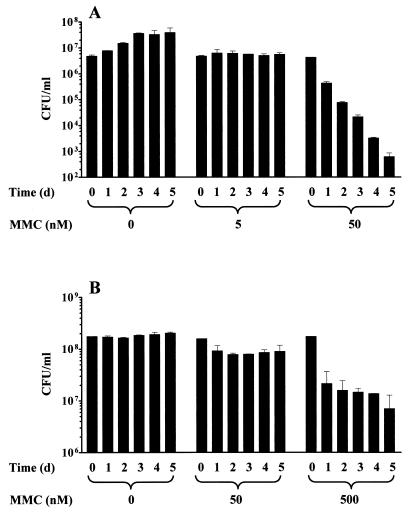Persistence of Mycobacterium tuberculosis infection despite prolonged chemotherapy is a major problem in tuberculosis control (3). Hypoxic dormant bacilli are, in contrast to oxic replicating organisms, not effectively killed by conventional antimycobacterials and could be one of the factors contributing to the persistence (1). Metronidazole (7), nitrofurantoin (4), and PA-824 (a nitroimidazopyran) (5) are the first leads that show activity against dormant bacteria. The compounds appear to act as prodrugs that require reduction of their nitro group to reactive intermediates that then cause damage and death of the bacilli. The finding that prodrugs that require reduction to unfold their antimicrobial activity are effective against hypoxic dormant bacilli prompted us to question whether mitomycin C might possess antidormancy activity. This drug is used in the chemotherapy of hypoxic solid tumours and requires reduction to become biologically active (6). Here, we report the analysis of the antimicrobial activity of mitomycin C on growing and dormant Mycobacterium bovis BCG Pasteur ATCC 35734. Mitomycin C showed an MIC (4) of 5 nM (1.7 ng/ml). In agreement with our previous report, a 104-fold-higher MIC (50 μM) of nitrofurantoin was observed and metronidazole did not show inhibition of growth (MIC of metronidazole > 1,000 μM) (4). Figure 1A shows that mitomycin C at MIC appears to be bacteriostatic. Incubation of growing cultures with 10 times the MIC of mitomycin C (50 nM) resulted in a 104-fold decrease in viability after 5 days. To grow dormant organisms, we employed the Wayne dormancy culture system. Wayne's model is based on growth of the bacilli in sealed tubes with stirring. Initially the cultures grow exponentially and consume oxygen. A temporal oxygen gradient is generated, and when oxygen is depleted the cultures enter stationary phase. The hypoxic stationary-phase bacteria do not replicate but maintain viability; they are in a state of dormancy (2, 8). Figure 1B shows that exposure of dormant bacilli to 500 nM mitomycin C resulted in a 30-fold reduction in viable counts after 5 days. To achieve a kill that was similar to that observed for mitomycin C, a 1,000-fold higher concentration of nitrofurantoin was required: 500 μM nitrofurantoin reduced viability of the dormant culture 90-fold after exposure for 5 days, while 500 μM metronidazole reduced viability of the oxygen-starved culture only 2-fold after exposure for 5 days (4). Comparison of the activities of mitomycin C against growing (Fig. 1A) and dormant (Fig. 1B) cultures shows that the growing bacilli were more sensitive to the drug. Furthermore, it is interesting to note the difference in the exposure time-kill curves for growing and dormant cultures. Growing cultures were killed (as expected) in an exposure time-dependent fashion. In contrast hypoxic cultures appear to lose viability rapidly 10-fold, and then the CFU level off. Whether this indicates the presence of a mitomycin C-resistant subpopulation in the dormant culture remains to be elucidated.
FIG. 1.
Effects of mitomycin C (MMC) on the viability of oxic growing (A) and hypoxic dormant (B) BCG cultures. CFU were measured by plating and colony counting. The experiments were carried out two times with duplicate cultures exactly as described previously (4). Mean values and standard deviations are shown. MMC (Roche) stock solution was prepared in water. Significant clumping or pH changes were not observed. Drug-containing dormant cultures were diluted at least 103-fold before the plating. Thus, dilutions of dormant cultures contained less than 10% of the MIC. However, determination of survival of growing cultures exposed to the maximum mitomycin C concentration used (50 nM) required plating of undiluted culture samples on days 4 and 5. To directly examine possible drug carryover effects, culture was diluted in broth containing 50 nM mitomycin C and plated immediately together with drug-free controls. CFU of drug-containing and drug-free samples were similar, demonstrating that drug carryover effects were negligible.
In conclusion, the comparison of the effects of mitomycin C and the nitroheterocyclic drugs on dormant bacilli revealed that mitomycin C showed activity at a 1,000-fold-lower concentration. Furthermore, mitomycin C showed a drastically lower MIC.
Acknowledgments
We thank Marianne Eleuterio for discussion.
This study was supported by the Institute of Molecular and Cell Biology (IMCB).
REFERENCES
- 1.Dick T. Dormant tubercle bacilli: the key to more effective TB chemotherapy? J Antimicrob Chemother. 2001;47:117–118. doi: 10.1093/jac/47.1.117. [DOI] [PubMed] [Google Scholar]
- 2.Lim A, Eleuterio M, Hutter B, Murugasu-Oei B, Dick T. Oxygen depletion induced dormancy in Mycobacterium bovis BCG. J Bacteriol. 1999;181:2252–2256. doi: 10.1128/jb.181.7.2252-2256.1999. [DOI] [PMC free article] [PubMed] [Google Scholar]
- 3.Manabe Y C, Bishai W R. Latent Mycobacterium tuberculosis—persistence, patience, and winning by waiting. Nat Med. 2000;6:1327–1329. doi: 10.1038/82139. [DOI] [PubMed] [Google Scholar]
- 4.Murugasu-Oei B, Dick T. Bactericidal activity of nitrofurans against growing and dormant Mycobacterium bovis BCG. J Antimicrob Chemother. 2000;46:917–919. doi: 10.1093/jac/46.6.917. [DOI] [PubMed] [Google Scholar]
- 5.Stover C K, Warrener P, Vandevanter D R, Sherman D R, Arain T M, Langhorne M H, et al. A small-molecule nitroimidazopyran drug candidate for the treatment of tuberculosis. Nature. 2000;405:962–966. doi: 10.1038/35016103. [DOI] [PubMed] [Google Scholar]
- 6.Tomasz M, Palom Y. The mitomycin bioreductive antitumor agents: cross-linking and alkylation of DNA as the molecular basis of their activity. Phamacol Ther. 1997;76:73–87. doi: 10.1016/s0163-7258(97)00088-0. [DOI] [PubMed] [Google Scholar]
- 7.Wayne L G, Sramek H A. Metronidazole is bactericidal to dormant cells of Mycobacterium tuberculosis. Antimicrob Agents Chemother. 1994;38:2054–2058. doi: 10.1128/aac.38.9.2054. [DOI] [PMC free article] [PubMed] [Google Scholar]
- 8.Wayne L G, Hayes L G. An in vitro model for sequential study of shiftdown of Mycobacterium tuberculosis through two stages of nonreplicating persistence. Infect Immun. 1996;64:2062–2069. doi: 10.1128/iai.64.6.2062-2069.1996. [DOI] [PMC free article] [PubMed] [Google Scholar]



